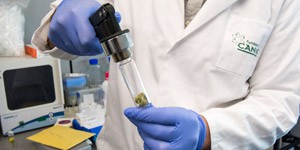By Guillermo Velasco

Associate Professor of the Department of Biochemistry and Molecular Biology I, University Complutense of Madrid and member of the board of directors of Observatorio Español de Cannabis Medicinal.
Cannabinoids have Antitumour Activity in Animal Cancer Models
Research conducted by various laboratories in the last 15-20 years has shown that marijuana derivatives (and specifically the plant’s main active ingredient, delta-9 tetrahydrocannabinol or THC) have antitumour activity in animal cancer models. Studies have therefore firmly established that the administration of cannabinoids in these models is able to reduce the growth of tumours in the brain (gliomas), breasts, pancreas, skin (melanoma and skin carcinoma), liver, prostate, etc.
Much of this research has helped us understand the mechanisms that cannabinoids employ to produce these antitumour effects. THC, the plant’s main active ingredient, produces its effects in the body by acting on the endocannabinoid system. This system is composed of “endocannabinoids”, molecules of a lipid nature (not water soluble), which are produced by our body’s cells and by the cannabinoid receptors (CB1 and CB2, proteins present on the surface of numerous cells of various organs and tissues; these proteins are particularly abundant in certain regions of the brain). The binding of endocannabinoids to CB1 and CB2 receptors helps regulate numerous physiological processes such as appetite, movement and pain. THC is capable of binding and activating cannabinoid receptors, thereby mimicking the endocannabinoids’ effects in the body.
In the case of the cannabinoids’ antitumour actions, we now know that they are also due in large measure to the ability to activate the CB1 and CB2 receptors present in the tumour cells, which leads to the triggering of a series of processes within these cells that result in programmed death (or “apoptosis”). Recent studies have indicated that THC activates apoptosis in tumour cells by means of a complex signalling pathway that leads to the stimulation of another cell process called autophagy (literally, self-digestion). Studies have also discovered that, in addition to promoting tumour cell death, cannabinoids can contribute to blocking tumour growth through the inhibition of tumour angiogenesis (a process by which the tumour modifies blood vessels in such a way as to more easily obtain the nutrients and oxygen it needs to grow). Cannabinoids also inhibit the tumour cells’ capacity to migrate and invade other tissues.
Studies to date have indicated that THC is the phytocannabinoid (plant-derived cannabinoid) with the most potent antitumour action. However, research by different laboratories has also found that cannabidiol (CBD), another component of C Sativa, can reduce tumour growth in animal models, although in most cases this effect is less potent than that produced by THC. The precise mechanism by which CBD (which does not bind effectively to cannabinoid receptors) produces its anticancer activities has not yet been clearly identified, although it is known that it also depends on this compound’s capacity to trigger apoptosis in tumour cells. Studies have also observed that the combination of THC and CBD in a 1:1 proportion allows reducing the THC dosage required to produce an antitumour effect in animal models of glioma. It is important to note that the possible antitumour activity of other compounds produced by Cannabis sativa, including phytocannabinoids other than THC and CBD or certain terpenes, as well as the presence of an “entourage effect” or boosting effect resulting from the combination of some of these compounds present in the plant, has no solid scientific evidence at this time (either in cell or animal models). Therefore, it remains a potentially attractive possibility but one that still needs to be demonstrated, particularly in the context of the antitumour activity of cannabinoids.
An especially relevant issue to consider is that cannabinoids act selectively in tumour cells. Thus, treatment with these compounds does not lead to apoptosis activation in nontumour cells. The precise reasons for this difference in cannabinoid action between tumour and nontumour cells are not known. However, this observation is important because it helps explain the low toxicity of cannabinoids when compared with other antineoplastic agents.
Combinations of Cannabinoids and Other Antitumour Agents
Various studies conducted with animal models have indicated that cannabinoids boost the antitumour action of a number of chemotherapy agents. For example, the combination of THC or THC and CBD with temozolomide (the drug typically used for treating brain tumours) demonstrated a more powerful effect in animal glioma models than that produced by these same drugs when administered separately. These observations suggest that cannabinoids could be tested as part of the combinations of chemotherapy drugs employed in treating cancer. In any case, given the marked differences in terms of the characteristics and sensitivity to the various therapies between each type and subtype of tumour and the considerable number of possible drug combinations, we need to continue implementing these types of preclinical studies to determine in what specific cases (tumour types and subtypes, combinations of different compounds) would be potentially more appropriate for including cannabinoids as part of the antitumour treatment.
Why Conducting Clinical Trials is Essential
Although the preclinical studies mentioned above are highly encouraging and suggest that cannabinoids could be useful in treating certain types of tumours, there is still a long road ahead for cannabinoids drugs to be prescribed for treating brain tumours or other types of cancer. We should consider that many anticancer drugs that showed promising results in animal models were not effective (or at least no more effective than the drugs already being employed) when tested on humans. Thus, clinical trials are essential for determining whether cannabinoids are useful in treating cancer (or at least some types of cancer), because they are the only means by which the efficacy of these compounds can be clearly demonstrated and thereby accepted by the international medical and scientific community.
It is important to note the difference between the results of a clinical trial and anecdotal observations or those of individual cases. For example, there are a number of cases of patients who have reported experiencing significant improvement or even, in a number of cases, having been cured of cancer after following a treatment with medicinal cannabis. Without denying the possibility that in some or many of these cases the healing was due to cannabinoid treatment, there could be other circumstances (e.g., other simultaneous treatments, diet changes and interaction with other diseases) that could be responsible for the change experienced by the patient. These individual cases cannot be used as a conclusive proof of the antitumour activity of cannabinoids in humans, although it can be used as an argument to justify the implementation of clinical studies that would allow the claims to be corroborated.
Towards the Implementation of Clinical Trials in Humans
At present, there are a very limited number of clinical studies that have analysed the effect of cannabinoids as antitumour agents. Approximately 10 years ago, an initial pilot phase I clinical trial (phase I studies primarily seek to analyse the potential toxicity associated with a new drug treatment) was implemented to analyse the effect of administering THC to patients with glioblastoma multiforme (the most aggressive type of brain tumour) who had experienced a relapse of the original tumour. This trial obtained encouraging data that indicated that THC causes no toxic effects in patients and suggested that this compound is capable of acting against the tumour cells. In any case, due to the type of trial implemented and the small number of patients who were treated, conclusions could not be extracted regarding patient survival, although it did lay the foundations for implementing future studies. For example, a clinical trial has recently been completed that analysed the combined action of the drug Sativex (a drug that contains THC and CBD in the same proportions) and temozolomide in patients with recurrent glioblastoma multiforme, the results of which are expected to be published in the near future. Similarly, there are other studies that have just ended or are planned to start up in the coming months. These studies have or will analyse the effect of various cannabinoids (individually or combined with other drugs) on brain tumours or solid tumours.
The results of these trials (and those of other trials that might be implemented in the coming years) provide important information regarding the antitumour activity of cannabinoids in humans, as well as the reasons for which these compounds can be more or less effective in treating a certain tumour type or subtype. This information will be crucial for performing further studies and determining, in the medium to long term, whether cannabinoids can be incorporated as part of antitumour treatments, at least in some cancer types or subtypes.
Current Situation
Considering the above, it is certain that, in the absence of the results of clinical trials (which will take years in providing conclusive data), there is currently insufficient scientific evidence to conclusively confirm that treatment with cannabinoids can help improve the current therapies administered to patients with brain tumours or other types of tumours. The administration of cannabinoid drugs or medicinal cannabis as part of the standard treatment for treating these diseases is therefore not currently approved (or subsidised).
In any case, given the solid evidence of cannabinoids’ antitumour activity in animal models, the fact that cannabinoid drugs have shown their usefulness in alleviating the adverse effects of other antineoplastic drugs and that the adverse effects of cannabinoids are mild when compared with other chemotherapy agents, many patients ask whether the use of cannabinoids could be of some help in treating their disease, particularly when other therapeutic options have failed.
The recommendation for those patients who are interested in using cannabinoids as part of an antitumour treatment is to consult physicians who have experience in the therapeutic use of cannabinoids and who can be contacted through patient associations interested in the therapeutic use of cannabis derivatives. These doctors can therefore recommend the use of cannabinoid drugs (which in a number of occasions may be prescribed as, for example, compassionate therapy). Theoretically, there is also the option of using cannabis extracts or oils of controlled origin that contain known concentrations of THC and CBD and thus allow the doctor and patient to know the quantity of active ingredient the patient is taking. In any case, the use of these types of extracts that contain THC is not legal in Spain or in other European countries. The administration of cannabis oils or extracts of uncontrolled origin (in which the quantity of THC and CBD they contain is not known, as well as the possible presence of contaminants [e.g., pesticides, herbicides, heavy metals and organic compounds derived from the extraction process]) could pose a risk for the patient. Similarly, the substitution of a conventional therapy by another based only on the use of cannabinoids is not justified from the basic research and preclinical point of view and also deprives the patient of the possibility of benefiting from therapies that have already demonstrated at least a certain level of efficacy. Therefore, in those cases in which the decision is made to test a treatment with cannabinoids in patients with cancer, the most logical starting situation would be maintaining the therapy that each patient is undergoing to treat their disease and progressively adding (always after consulting with an oncologist or at least with a physician with expertise on the subject) an appropriate quantity of the cannabinoids.
Summary/Conclusions
In summary, there is currently solid evidence indicating that cannabinoids (particularly THC and to a lesser extent CBD) have antitumour activity in animal models. However, until we get data from clinical trials, we cannot determine whether this antitumour activity could be useful for treating cancer in humans. Considering the accumulated experience in the clinical use of cannabinoids for treating other diseases, the low toxicity of these compounds when compared with other anticancer drugs and its usefulness as drugs that can relieve the cancer-associated symptoms and the adverse effects of anticancer therapies, there is a growing number of patients who, given their urgent situation, consider the possibility of including these agents as part of their treatment without waiting for the results of these clinical trials. In these cases and pending the clear regulation of the use of medicinal cannabis, the main recommendations for preventing risks for the patient are as follows: Always consult a physician, if possible with experience in the therapeutic use of cannabinoids (in certain cases, patients associations interested in the use of medicinal cannabis can help with this contact) and employing treatments (such as complementary therapy and not replacing the treatment the patient is currently undergoing) or cannabinoid drugs or extracts of controlled origin that contain known quantities of THC and CBD (it should be emphasized in the latter case that extracts that contain THC are not legal in Spain or in other European countries) so that the most appropriate dosage of these compounds can be prescribed for the patient.


